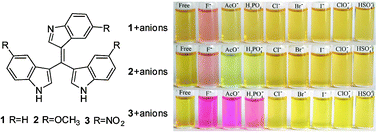The search for new host molecules for anion recognition and sensing through hydrogen bonding interaction has been an active research area, due to the importance of anions in a wide range of medicinal, environmental and biological processes. One of the most attractive approaches in this field involves the construction of colorimetric chemosensors since naked eye detection can offer qualitative and quantitative information.
Based on their previous research on the simple chemosensor utilizing bis(3-indolyl)methene (BIM) skeleton as building blockwhich allows for the colorimetric detection of F- and AcO- in organic aprotic solution based on the proton transfer signaling mode, researchers of the Key Laboratory of Chemistry of Northwestern Plant Resources have designed, tris(indolyl)methene, a new kind of unexplored chromogenic molecules based on BIM skeleton. It has been proved to be n excellent chemosensor for F- by two stages of proton transfer, and could also distinguish AcO- and H2PO4- through spectral behaviors. The introduction of the electron donating group into the tris(indolyl)methane skeleton decrease the binding ability of the hydrogen bond site, which partially inhibit the occurrence of the deprotonation, and improve the selectivity. In contrast, the introduction of the electron withdrawing group increases notably the proton acidity of the hydrogen bond donor moiety, and promotes the occurrence of the reversible deprotonation, while improving anion affinity and response sensitivity of the receptor, and reduced the anion selectivity. Consequently, as a promising building block, the BIM skeleton seems to be general for developing more anion receptors and sensors through some modification.
The work has received support from the National Natural Science Foundation of China and the open fund of State Key Laboratory of Oxo Synthesis & Selective Oxidation of the Lanzhou Institute of Chemical Physics of the CAS.
The findings have been published in Org. Biomol. Chem. (Org. Biomol. Chem., 2011, 9, 752–757).
Org. Biomol. Chem.Paper
